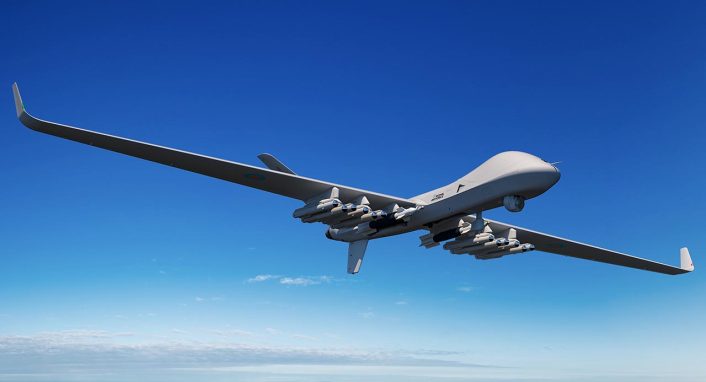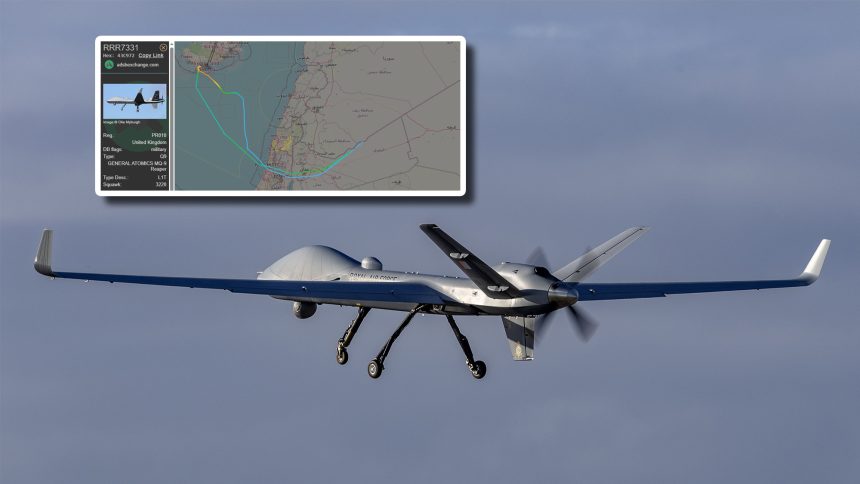After initial sorties over the sea south of RAF Akrotiri, flight tracking data now confirms that the RAF’s MQ-9B Protector RG1s have begun missions over the Middle East, presumably on Operation Shader.
PR010, an MQ-9B Protector RG1, was tracked departing RAF Akrotiri and flying over Israel and Jordan towards the usual Operation Shader operating areas over Iraq and Syria on two separate occasions in the past week. It is almost certain they have now assumed the Reaper’s role on this ongoing mission, which commenced in 2014.
Since the withdrawal of the MQ-9A Reaper at the end of September questions had been raised as to whether the Protector had taken over providing intelligence, surveillance, and reconnaissance (ISR) in the region. Instead of flying from Akrotiri, the Reapers operated from Kuwait and did not show on flight tracking websites. It is still possible that Protectors have flown missions from alternative locations and not shown, but the now confirmed use of Akrotiri-based airframes would seem to make that more unlikely.

We do not yet know if these missions have been flown using armed aircraft or have been purely dedicated to ISR. While airstrikes are now rare, given the massive loss of territory and personnel suffered by Daesh over the previous decade, they do still occasionally take place. In the Reaper’s last month of operation the fleet conducted two strikes against known terrorists in Syria after previously carried out none since February.
The Aviationist first reported in October that the Protector RG1 fleet had begun flying from RAF Akrotiri, a base contained within British territory on the island of Cyprus, and we speculated that some of the flights could have been dry runs for future sorties like the ones that we are now seeing.
MQ-9B SkyGuardian® is the next generation of #RPAS delivering persistent intelligence, surveillance and reconnaissance around the globe. Designed to fly over the horizon via satellite for up to 40+ hours in the harshest weather and safely integrate into civil airspace,… pic.twitter.com/6nnGd6IRBx
— General Atomics Aeronautical Systems, Inc (GA-ASI) (@GenAtomics_ASI) August 26, 2025
Protector RG1 is the UK designation for what GA-ASI markets as the MQ-9B SkyGuardian. It follows the typical UK naming convention for aircraft with a given name followed by a role designation and mark number. In this case the latter part can be broken down as Reconnaissance, Ground Attack, Mark 1. As with many recent UK aircraft acquisitions, the Protector fleet has been assigned out of sequence serial numbers beginning with PR (standing for Protector). Theoretically, current in-sequence serial numbers would begin with a Z, though even in this range the use of specially chosen out of sequence numbers (for example ZP801-ZP809 for the P-8 Poseidon MRA1, and ZZ330-ZZ343 for the A330 MRTT Voyager) means there are many gaps of unassigned serials.
UKSerials notes that the first Protector RG1 was assigned the serial PR005. The first aircraft to take flight in the UK was PR009, and we have noted airframes PR010 and PR011 operating from RAF Akrotiri. The first few airframes are likely those which are due to stay in the United States for the foreseeable future to continue with trials and testing.
Reaper to Protector
While both the Reaper and Protector are from the same family of aircraft, the MQ-9B variant brings a number of major improvements that offer a greater level of flexibility. The MQ-9B boasts redundancy levels that would typically be more suited to manned aircraft, including lightning and fire protection systems and anti-icing equipment, while rigid separation is maintained between mission systems and flight critical software. This allows the MQ-9B to operate in unsegregated airspace even in countries where separation of manned and unmanned aircraft is usually subject to strict protocols, like the UK.
Protector additionally offers a greater range over its predecessor, with a stated endurance over over 40 hours. Its larger wing also provides for a greater maximum take-off weight (MTOW) allowing more weapons or other payloads to be carried at any one time. Though official comment on sensor payloads is scarce to the point of almost non-existence, we know that the RAF procured at least two types of additional ISR equipment for use on its Reaper aircraft through documents released following Freedom of Information Act (FOIA) requests and images released by official sources.

The FOIA documents revealed the purchase of the ‘Outdragon’ SIGINT system, which is carried on the aircraft’s wing, while many images have depicted undisclosed flat panel antennas mounted on each side of the forward fuselage. It is likely that further undisclosed payloads have been procured. Given the lack of any significant comment regarding the existence of these capabilities, understandably there is no confirmation whether these have already been integrated onto the Protector RG1 or are intended as a future capability.

Similarly, with weapons, the exact status of integration processes are unclear, though it seems likely that UK weapons have been cleared for at least some use. Unlike the Reaper, which relied on weapons otherwise not operated by the RAF like the Hellfire missile and GBU-12 Paveway II, the Protector RG1 is envisioned to operate with the same Brimstone missiles and Paveway IV bombs already deployed from Akrotiri by the RAF’s Typhoon fleet.
Testing of the RAF’s new Remotely Piloted Air System (RPAS) is continuing apace with ground vibration tests of the MQ-9B SkyGuardian, which will be known as Protector in RAF service, carrying @byMBDA Brimstone 3 missiles and Paveway IV bombs.#NextGenRAF #SecuringTheSkies pic.twitter.com/VvKJz4EqeY
— Royal Air Force (@RoyalAirForce) July 24, 2020
Official statements by the RAF have referred to these weapons being carried by Protector in the present tense, but that could still be referring to theoretical rather than present capability. A 2019 release by MBDA stated “Brimstone integration will be completed in time for the entry to service of the aircraft with the RAF”, however, much can change in six years.
Thanks to eagle-eyed flight tracking aficionados @ameliairheart and @SR_Planespotter for catching these flights as they happened, allowing this article to be written.









